![]()
![]()
![]()
Use LEFT and RIGHT arrow keys to navigate between flashcards;
Use UP and DOWN arrow keys to flip the card;
H to show hint;
A reads text to speech;
19 Cards in this Set
- Front
- Back
|
Overview of all of the RNA viruses by category and morphology:
|
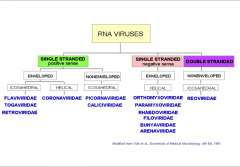
|
|
|
RETROVIRIDAE KEY POINTS:
-structure -polarity -unique traits -two genera |
Enveloped, icosahedral nucleocapsid
Genome consists of TWO COPIES of positive-sense RNA Virion carries RNA-dependent DNA polymerase (Reverse Transcriptase), other enzymes and tRNA. Replication proceeds through a DNA intermediate (provirus) Two genera of human interest: - Oncovirinae (HTLV-1, HTLV-2, HTLV-5) - Lentivirinae (HIV-1, HIV-2) |
|
|
Do RNA tumor viruses cause cancer?
|
No-- they are risk factors for cancer, though.
|
|
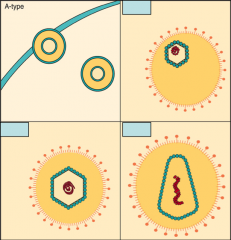
What kind of virus is this and what types?
|

Retroviruses.
C type is HTLV D type is HIV |
|
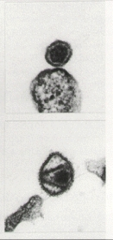
|
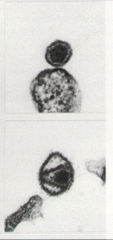
top: C-type (HTLV)
bottom: D-type (HIV) |
|
|
Describe the structure of Retroviruses:
-RNA # -important enzymes -glycoproteins |
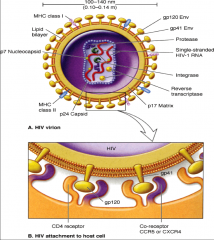
-Diploid RNA
-Associated with reverse transcriptase, integrase, and a protease -GlycoPROs: gp120 for attachment; gp41 involved in membrane fusion |
|
|
∆ b/t oncoviruses and lentiviruses in their cytolicity and methods of spread:
|
-Oncoviruses are spread cell to cell, and aren't cytolytic
-HIV spreads cell to cell, is cytolytic, and can travel as a free virus as well. |
|
|
What genes do simple retroviruses have?
|

GAG : internal proteins
ENV: Envelope glycoproteins POL: Enzymes--Reverse transcriptase, Integrase, Protease - Long Terminal Repeats are used by viruses to insert their genetic material into the host genomes. |
|
|
Summary of simple retrovirus gene products and their functions:
|
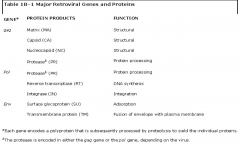
|
|
|
∆ b/t a simple retrovirus and a complex one?
|
A complex retrovirus has the 3 genes + additional accessory genes.
|
|
|
Describe Attachment and Entry of a retrovirus into the host:
|
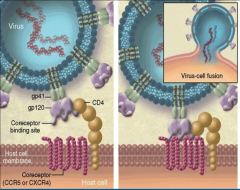
-Need CD4
-Coreceptor is key for binding (CCR5 on macrophages or CXCR4 on activated T cells). -Viruses can mutate b/t being T-trophic or macrophage-trophic. |
|
|
Describe the replication of retroviruses:
-what is a key ∆ b/t onco and lenti viruses in this step? |
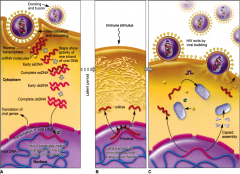
1) ssDNA formation
2) dsDNA formation 3) insertion into host genome *oncoviruses stay in this integrated state permanently; don't bud as often *HIV is cytolytic; more often buds out and moves on. |
|
|
At what steps in replication are key enzymes involved?
-reverse transcriptase -integrase -host RNA Polymerase |
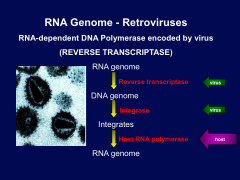
|
|
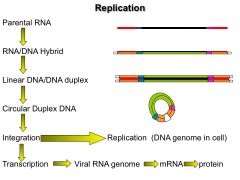
List the key enzyme acting at each step:
|

|
|
|
What do oncoviruses cause?
What are the two mechanisms of oncogenesis in oncoviruses? |
-Associated with the development of leukemias, sarcomas, and lymphomas.
* Direct or acute transforming retroviruses, which rapidly transform cells and are highly oncogenic [animals] *Indirect or transactivating retroviruses, which promote uncontrolled cell growth by transctivation of cellular genes; group includes HTLV-1 and HTLV-2 [humans] |
|
|
What do oncogenes encode?
4 |

-Proteins that are involved in growth control and differentiation
-Growth factors -Growth factor receptors -Signal transduction proteins -Transcription factors |
|
|
Key points regarding Human T-lymphotropic virus (HTLV-1):
-what key protein is made by it? -associated disorders? |
-It's an Indirect/transactivating retrovirus.
-Can cause human cancer after a long latency period -Involves viral transcriptional regulator called tax -Associated with lymphoid malignancies; virus infects CD4 helper T cells. -Associated with a neurologic disorder (HTLV associated myelopathy/tropical spastic paraparesis; HAM/TSP) -Transmission is via cell-to-cell contact during exchange of body fluids. |
|
|
HTLV life cycle and spread:
|

-Upregulation of tax increases IL-2; which increases CD4 proliferation --> T cell leukemia
|
|
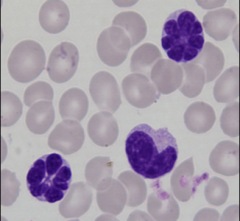
|

Transformed "flower" T cells from HTLV.
|

